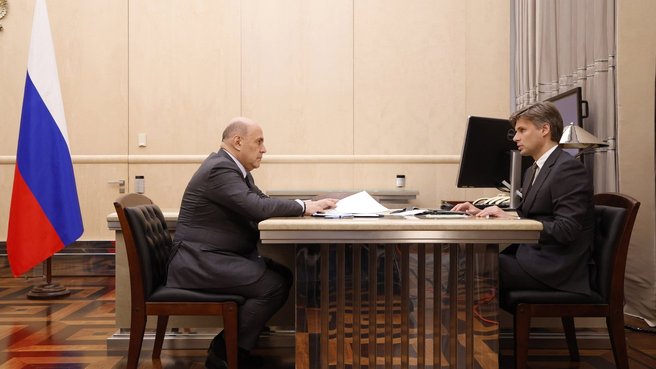The development strategy of the state corporation in the context of the implementation of the new national project on space activities was discussed.
From the transcript:
M.Mushin:
Dear Dmitry Vladimirovich!

Meeting Mikhail Mishustin with the General Director of Roskosmos State Corporation Dmitry Bakanov

General Director of Roscosmos State Corporation Dmitry Bakanov
Meeting Mikhail Mishustin with the General Director of Roskosmos State Corporation Dmitry Bakanov
You head the state corporation for space activity, which is responsible for space research. And here is a very large influence on related industries. The corporation is also actively engaged in science, technology.
The president emphasized that when implementing national projects, “you need not to simplify your tasks, but, on the contrary, set ambitious, but adequate goals and accumulate all possible means and resources for their confident achievement.”
I must say that active work over the past few months, led by the President, made it possible to complete the study of a new national project on space activity. Its financing provides about 4 trillion rubles until 2036. First of all, we will direct these funds to maintain the competitiveness of the Russian space industry.
Tell us
What is being done in the direction of implementation of the national project, which began its countdown, and in general in the corporation.
D. Bakanov: Dear Mikhail Vladimirovich!

General Director of Roscosmos State Corporation Dmitry Bakanov
A new national project in the field of space was approved, which includes eight federal projects, a number of them are aimed at absolute competitive advantages in the field of space – this is nuclear energy in space and scientific cosmos.
The main challenge today is that if literally five to ten years ago only two or three countries had the necessary space technologies, now this number has grown to 10–12-they are still competing in pricing.
We have in order to be in the leaders, there are two main directions.
First. This is a competition in launch vehicles. Now several countries have already have the technology of the first stage returned. And we also went in this direction. And, as you know, the Amur launch vehicle, which will be on methane, on liquefied natural gas, will have exactly the returned first step.
By the end of the year, at our Baikonur cosmodrome, the Baiterek project is being implemented together with Kazakhstani partners. The Kazakhstan side took on the construction of the starting table, and Roscosmos-obligations to launch the new Soyuz-5 missile, and this launch is planned for December this year.
The second direction is a conveyor assembly of satellites. Now orbital groups are growing massively. Russia also has appropriate technologies. One of the operators unfolds the group in more than 300 devices. And at the end of this year there will be the first serial launch. This is a technology when we work out and the adapter for their breeding in orbit. And in principle, the Russian Federation has not yet created a group of more than 300 spacecraft.
M.Mushin:
I ask you to strengthen the work in two more directions.
First of all, it is necessary to increase the economic efficiency and financial stability of industry enterprises. Provide the possibility of involving a private business in production chains. This is very important. And of course, it is necessary to do this together with the Ministry of Finance, which will strengthen the competitive potential in general and attract extrabudgetary financing. And this is the second task, since the interest in space technologies in private business is huge. And the capitalization of this interest should also be the target task of Roscosmos.
And yet. Special conditions are presented to the activities of Roscosmos. Technologies that are used in state corporations should be domestic, meet the highest possible safety requirements.
You have been engaged in digital technologies for many years, were responsible for digital transformation. How do you assess the level of digitalization in Roscosmos? And what technologies are you going to continue to engage in taking into account the need to use mainly domestic software?
D. Bakanov:
Yes, the efficiency of production today cannot be increased without the use of digital tools. Here we plan to move in three directions.
First. This is the so -called heavy software. Two most striking examples.
Firstly, this is mathematical modeling when working out engines at the stand. The Keldysh center, due to this mathematical modeling, was able to reduce the number of burners from eight to four, that is, efficiency doubled. Due to the modeling of a number of processes, we do not go to the stand with the engine, but do it on the computer. This directly affects the cost of the product.
Secondly, it is the so -called PLM. This is a full development cycle. Here, in addition to import substitution, we should increase the efficiency of production processes by introducing such technologies. And the Russian orbital station, which will replace the international space, is just developing on a similar Russian software product.
Moreover, as we reported to you at the CIPR, in addition to one organization – RSC Energia, the head of the development of our new orbital station, we connect the entire list of cooperation. This is the Khrunichev Center, which the Angara launch vehicle will do for it, and the Tsenki is the center of operation of ground-based space infrastructure facilities that prepares the cosmodrome. Thus, we will see through the whole chain of creation of the product in a through way.
The second, no less important direction is work with personnel. There is also domestic development, when we are not just conducting personnel administration, but we involve employees in the so -called social network of Roscosmos. When, besides the fact that we evaluate them, we also receive feedback from them: how they evaluate the employer.
And if we talk about digital development, it is impossible not to mention artificial intelligence. Here, with one of the market leaders, we cook two products. The first is an astronaut assistant aboard the ISS, in order for research, tests that are carried out there are most effective. And the second direction is the use of neural networks to increase the accuracy of the images of remote sensing of the Earth (DZZ). Mentioning this market, you asked the question of attracting private investors. Just the DZZ market is one of these areas.
What is meant? That for the state it is costly to constantly maintain an orbital grouping in the amount of 30–40 optical surveillance devices in orbit. And here, by attracting private capital, we could unload the cost of Roscosmos. To do this, together with the Ministry of Finance, on your order, we provided the appropriate funds for the redemption of these services by qualified customers – state bodies. Thus, the Gorosa customers buy highly defined resolutions, pay for this at a market tariff, the same as in the world market, and due to this money, private traders return their CAPEX.
M.Mushin:
In the course of updating the development strategy of Roscosmos, of course, it is necessary to analyze competitors’ decisions. You yourself said, several countries are now working in the field of space research, the returned steps are performed. Therefore, you need to watch very carefully where what solutions are used, and as much as possible to prioritize the use of Russian products, software, in particular heavy software, automated design systems, and life cycle systems. It is very good if it is implemented on Russian systems.
In terms of personnel, no doubt, the most important question. You said about personnel training. For the space industry, this takes a lot of time. Here, an artificial intelligence system will not replace professionals who traditionally work in this area in Russia. These are people who are respected in society – astronauts, technicians, engineers, scientists.
I want to wish you good luck and implementation of all planes.
D. Bakanov:
Thank you.

